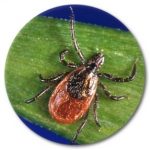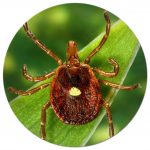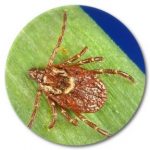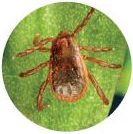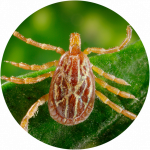HOW I-TICK WORKS
What is I-TICK?
I-TICK, (Illinois Tick Inventory Collaboration networK), is a surveillance program to gather information about ticks of public health concern in Illinois. The purpose is to develop a network of volunteers to collect data to help our lab determine the risk of tick-borne disease based on where and when ticks occur.
Why would I want to take part and why is it important?
Ticks can carry a number of diseases that affect people and other animals. The data collected help identify where and when a tick comes in contact with people, pets, and livestock. These data then allow us to focus surveillance methods to determine the risk of disease. Additionally, the Tick App will provide information on what human activities affect the risk of finding a tick.
Who can participate?
Anyone in Illinois is welcome, but participants must be 18 years or older to use the Tick App.
While the Tick App is for anyone to use regardless of their location in the U.S., our I-TICK program will only analyze data from Illinois. If you are traveling and find a tick anywhere in the U.S., you may still submit the information using the Tick App–the data are useful to other research programs studying tick-borne diseases.
When does it occur?
The I-TICK program collects data any time, regardless of season or time of year.
Where does it occur?
Anywhere in Illinois, where a person works or relaxes, including your yard or property.
The location where the tick was found is critical to I-TICK! We require at least the county of collection to include the data in our research. Please submit location and date with any frozen tick. If you use the Tick App, you can enable the location function on your smart phone if you are comfortable doing so. If not, there is a place in the Tick App to manually record location. Please provide at least the county, but even better, a more exact location such as the city or state park. (The information provided by volunteers is more valuable when a precise location is provided instead of just the county where a tick was found). All data are always kept confidential.
What will it cost me to participate?
The Tick App is free for anyone to use, but you will have to pay for your cell phone data. There is also a desktop version if you prefer or do not have a smart phone. If you collect and freeze a tick to mail to us, your cost would be a first class stamp.
How do I participate?
There are two ways to participate in I-TICK: send us a physical tick specimen that is NOT engorged with blood, or collect and submit all information using The Tick App: a smartphone or web app. Participants are free to choose one (or both) methods.
- To use The Tick App:
-
- Download the free Tick App in Google Play or the AppStore, seewww.thetickapp.org.
- Read the consent form, create an account and complete the enrollment survey.
- Complete a daily log of outdoor activities, tick protection methods used and tick encounters.
- Found a tick? Please take a picture and submit it in a daily log or tick report. Entomologists will identify the tick (if at all possible) and return that information to you.
- To mail a tick to the ITICK program:
-
- Place the tick on a paper towel that is wet,(not ‘dripping’),with rubbing alcohol into a sealable plastic baggie.
- Record relevant information on a piece of paper and send that with the tick.
- The date you found the tick (as close as possible)
- As specific a location as possible, e.g. name of park trail, but at a minimum, record the county where you believe the tick came from.
- Record whether or not you traveled outside your county within the last 10 days
- Please consider including your name and email on the paper. Your information is completely protected –we will only email you if we have a question.
- Place the bag with the tick and the paper with data you recorded into a second baggie and place it in the freezer for 1-2 days. Alcohol and freezing kills ticks, and the alcohol will evaporate.
- Be sure both baggies are completely sealed. It is OK to tape them shut.
- Using a regular business envelope and first-class stamp, please mail to:
- Dr. Lee Ann Lyons, 2420 VMBSB, 2001 S. Lincoln Ave., Urbana, IL 61802
- Please note: This method does NOT provide tick species identification–(the Tick App does).
What is the Tick App?
Please note:
While the Tick App is for anyone to use regardless of their location in the U.S., our I-TICK program will only analyze data from Illinois. If you are traveling and find a tick anywhere in the U.S., you may still submit the information using the Tick App – the data are useful to other research programs studying tick-borne diseases.
In previous years, participants collected ticks and mailed them to us using “tick kits” distributed through “hubs” throughout Illinois. In 2020, we discontinued the use of tick kits and ask participants to choose one or both of the other collection methods.
A note on “Tick Kits” distributed in 2018 and 2019:
In previous years, I-TICK participants collected ticks and mailed them to us using “tick kits” distributed to “hubs” throughout Illinois. We will not be sending out more tick kits. However, if someone still has a kit, they can put ticks in the vials, fill it with rubbing alcohol at least halfway, return the kit to their hub, and the hub will send the kit to us using the mailing label we provided with the kits.
How to use tick kits from previous years:
- Please add a bit of rubbing alcohol (if needed) to the vials so they are at least half full.
- Each day, you do not need to do anything differently. IF you find any ticks, place them in a vial. If you do NOT find any ticks, record that day as “no ticks”. (This is still important information).
- At the end of the day, record date you found the tick, location where you believe the tick came from, and note if you traveled outside your county within the last 10 days. It is especially important to record the county or counties where you traveled and where (if) you found a tick.
- Important! Place all ticks found in one day in 1 vial, no matter how many or what type – one vial/day. OR if ticks are collected at a completely different location or county, please use a separate vial.
- Please hold onto the kits in a safe place (avoid direct sunlight or high temperatures).
Program Information:
The I-TICK program is funded through the Upper Midwest Center of Excellence in Vector-Borne Disease, a consortium of Midwestern universities established in 2017 by the Centers for Disease Control and Prevention and headquartered at the University of Wisconsin, Madison. Program leaders at the University of Illinois Urbana-Champaign are Dr. Rebecca L. Smith, at the College of Veterinary Medicine, and Dr. Nohra Mateus-Pinilla, Director of the Wildlife Veterinary Epidemiology Laboratory at the Illinois Natural History Survey.The tick surveillance program and the Tick App are examples of the Center’s efforts to improve predictions of disease emergence and outbreaks and to optimize surveillance networks and pathogen detection. The I-TICK program at the University of Illinois at Urbana-Champaign is partnering with researchers at Columbia University, Michigan State University and the University of Wisconsin –Madison, members of the CDC Regional Centers for Excellence in Vector-Borne diseases, who developed the Tick App. Funding is provided by the Centers for Disease Control and Prevention.
Tick Identification
The 5 species of most concern in Illinois include:
Information from the CDC about identifying ticks.
For additional information about identifying ticks visit the IDPH website on common ticks in Illinois.

